
Environmental Protection & Occupational Safety
Occupational Health & Safety
To ensure employees and other workers' physical and mental health during working hours. In addition to complying with local labor laws and safety production regulations, USI has stipulated safety and health policies, objectives, standard procedures, and held educational training and LOHAS activities. All our facilities are certified with the ISO 45001 Occupational Health and Safety Management System. As per Company policy, we annually maintain our certification validity, satisfy local occupational health and safety regulations, and continue to provide a safe and comfortable workspace.
To understand and grasp the safety and production, the six major manufacturing facilities of USI are required by local laws and regulations to set up a Safety and Health / Production Committee by employees, with employee representatives as the management representatives of the committee, and the proportion of labor representatives is at least one-third in each facility in accordance with local laws and regulations. The frequency of the committee meetings varies from facility to facility, but regular meetings are held at least once every three months to coordinate and recommend occupational safety and health management matters. To ensure the safety and health of workers in the facility, USI invested CNY 159 million in safety production and chemical safety management in 2021. Occupational safety and health costs include employee insurance, physical check-up, labor protection, safety measures improvements, operating environment monitoring, and ISO 45001 certification fee.
Safety and Health / Production Committee's Responsibilities:
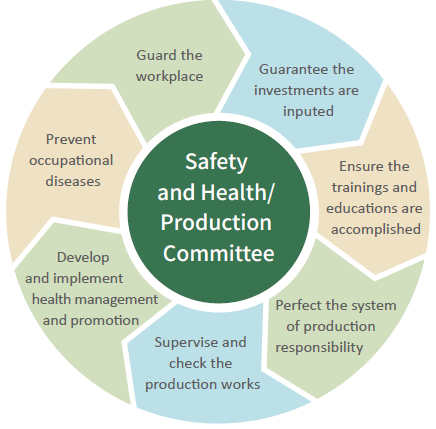
As part of the risk-based thinking required by the ISO 45001 Occupational Health and Safety (OHS) Management System, USI establishes a process to manage procurement, contracts, and changes. We implement necessary safety assessments, training, and data updating to reduce potential safety and health risks from operating conditions or the work environment. To effectively identify and assess safety and health hazards and risks and opportunities derived from the operations and work environment, we request responsible units to identify threats based on occurrence probability, exposure frequency, and consequence severity every year.
Hazard Identification and Risk and Opportunities Procedure:
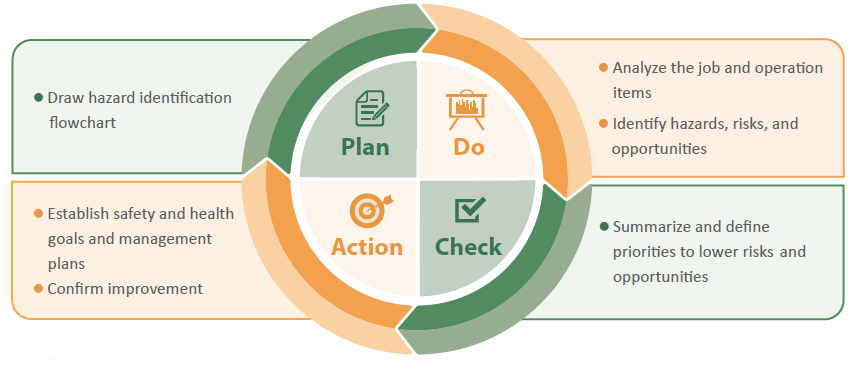
Management Measures for Hazard Identification and Risk Opportunity:
|
Risk and Opportunity Level |
Corrective Action |
Identification Result |
Hazard or Impact Above Medium Level |
Management Measures |
|---|---|---|---|---|
|
1. Serious |
|
There are no Serious or High-Level risks and opportunities in the work activities or working environment of USI facilities. |
||
|
2. High |
||||
|
3. Medium-High |
It must be reviewed whether there are still opportunities to improve the performance of occupational safety and health, such as:
|
Part of the factory operations and high-risk operations employees have Medium High or Medium Level risks and opportunities; others are Low or Slight Level risks and opportunities. |
Elevated operations: drop, fall |
Must wear safety belts and helmets and use compliant auxiliary equipment; set up the operation control area and have workers from the same industry to assist in the operation. |
|
Confined space operations: hypoxia |
Wear self-contained breathing apparatus and strengthen training. |
|||
|
4. Medium |
COVID-19: infectious diseases within facilities |
Carry out relevant requirements and measures for personnel access control, self-monitoring temperature, notification system, and environmental protection. |
||
|
5. Low |
Hot work operation: fire |
Must control fire sources and combustibles, wear personal protective equipment, carry spare fire extinguishers, and strengthen training. |
||
|
6. Slight |
Work environment (such as using organic solvents, X-Ray inspections): inhalation hazard, skin contact hazard or body pathology |
In addition to regular monitoring of high-risk operating environments (including lighting), special health inspections should be carried out. The inspection items include noise, carbon dioxide concentration, organic solvents, specialized substances, dust, lead workplaces, and free radiation; they require personal protective gear during operation. |
||
To ensure the safety of workers, each facility conducts automatic inspections in accordance with government regulations and the company's operating standards, and EHS personnel also conduct routine safety audits, which covers occupational safety, health, and hygiene, as well as management systems. In some facilities, the inspection results are included in the safety and health evaluation activities, and outstanding units are publicly recognized in the regular safety and health / production meetings to encourage personnel to participate in safety and health management and improvement measures.
Audit Results Over the Years:
|
Dimension / Year |
2018 |
2019 |
2020 |
2021 |
|---|---|---|---|---|
|
Safety |
598 |
330 |
376 |
747 |
|
Health |
142 |
53 |
108 |
121 |
|
Management System |
1 |
5 |
11 |
47 |
In addition, each facility commissions qualified third-parties to implement environmental monitoring and control operational hazards. At the same time, USI also regularly monitors high-risk operational environments to ensure that the concentration of harmful substances and noise are below threshold values, continuing to provide a healthy and safe working environment for all employees and workers.
Occupational Safety and Health Training
In order to enhance employees' awareness of occupational safety and health, USI has established "Environmental Safety and Health and Energy Education and Training Management Regulations" at each facility to draw up annual environmental safety and health education and training plans according to practical needs, and to conduct safety and health education and training for new recruits and in-service personnel, regulatory and certification training, management system operational training, emergency response training, and contractor education training, as well as arranging drills and tests for employees to enhance their knowledge and skills and their ability to deal with emergencies.
Occupational Health and Safety Training Data:
|
Items / Year |
2018 |
2019 |
2020 |
2021 |
|---|---|---|---|---|
|
Total Number of Courses |
Data not available |
183 |
207 |
410 |
|
Total Number of Trainees |
21,687 |
32,443 |
56,285 |
50,851 |
|
Total Training Hours |
41,686 |
21,942 |
48,411 |
57,776 |

To ensure that the relevant units can respond quickly when an occupational incident occurs, each facility has established procedures for accident investigation and handling, stipulating that if a near miss, occupational injury or occupational disease occurs in the facility, procedures such as first aid, reporting, investigation, and improvement measures would be carried out, and at the same time improvement measures are proposed based on the root cause of the accident. All improvement measures would be carried out across all facilities, and relevant continuous improvement would be tracked regularly to prevent the recurrence of similar accidents. There were no accidents resulting in injury or death of employees or damage to equipment resulting in production stoppage in 2021.
Occupational Injuries and Occupational Diseases:
|
Items / Year |
2018 |
2019 |
2020 |
2021 |
|
|---|---|---|---|---|---|
|
Employee |
Total Hours Worked |
39,253,041 |
45,670,981 |
42,065,676 |
44,539,170 |
|
Number of Lost-time Injuries |
6 |
14 |
12 |
14 |
|
|
Lost-time Injury Frequency Rate |
0.15 |
0.31 |
0.29 |
0.31 |
|
|
Rate of High-consequence Work-related Injuries |
0 |
0 |
0 |
0 |
|
|
Number of Work-related Fatalities |
0 |
0 |
0 |
0 |
|
|
Rate of Fatalities as A Result of Work-related Injuries |
0 |
0 |
0 |
0 |
|
|
Occupational Diseases Rate (ODR) |
0 |
0.02 |
0 |
0 |
|
|
Number of Days Lost Due to Injuries |
111 |
75 |
124 |
460 |
|
|
Lost Day Rate (LDR) |
2.83 |
1.64 |
2.95 |
10.33 |
|
|
Contractor |
Total Hours Worked |
1,312,732 |
4,868,030 |
3,766,409 |
3,157,842 |
|
Number of Lost-time Injuries |
0 |
1 |
1 |
0 |
|
|
Lost-time Injury Frequency Rate |
0.00 |
0.21 |
0.27 |
0.00 |
|
|
Rate of High-consequence Work-related Injuries |
0 |
0 |
0 |
0 |
|
|
Number of Work-related Fatalities |
0 |
0 |
0 |
0 |
|
|
Rate of Fatalities as A Result of Work-related Injuries |
0 |
0 |
0 |
0 |
|
|
Occupational Diseases Rate (ODR) |
0 |
0 |
0 |
0 |
|
|
Number of Days Lost Due to Injuries |
0 |
8 |
24 |
0 |
|
|
Lost Day Rate (LDR) |
0.00 |
1.64 |
6.37 |
0.00 |
|
Besides the requisition of contract project quality and schedule, USI values contractor's safety and health management. EHS & Energy Policy clearly commits "Raise workplace environment health and safety awareness through continuous communication with all employees, suppliers, distributors, contractors, and other business partners. Conduct training and drills to prevent environmental impact, excess resource waste, and safety hazards". Our Contractor and On-Site Construction Management Regulations were formulated using the concept and principle of the PDCA cycle, and we use the Regulations as our guidance to effectively manage and improve contractor occupational safety and health.
Contractor and On-Site Construction Management Regulations:

The quality of the contractor's personnel has a significant impact on the quality, duration, and safety of the work being contracted. Therefore, USI contractors are asked to provide the necessary documentation of education and training, as well as participate in occupational safety and health education and training conducted by USI. In 2021, 475 contracting companies, 7,363 participants undertook USI's occupational safety and health training. After training and evaluation by the EHS departments of each facility, a total of 2,627 contractor employees obtained construction permits.

USI provides on-site health consultation services to enhance our OHS Management and build a healthy workplace beyond regulation requirements. This health consultation program brings general and specialized doctors on-site, including psychologists, physiotherapists, nutritionists, and occupational specialists. We strive to not only prevent and reduce occupational injuries and diseases through these consultations but also provide employees with support programs that foster health and well-being. In 2021, USI employees logged 9,558 hours in 18,519 consultations.
In addition, USI has a nurse station equipped with changing dressing facilities, manometers and weighing scales, provide basic health services for employees. The station also provides a resting room, counseling room, and breastfeeding room for employees. Nantou Facility has received the Nantou County Excellent Breast Feeding (Collection) Room certification for eight consecutive years, continuing to provide a comfortable breastfeeding space for mothers.
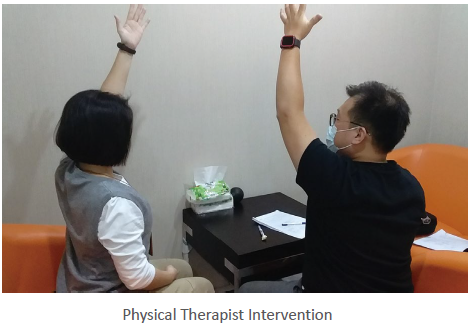
To effectively achieve health management, USI conducts physical check-ups each year. USI tracks employees with significant abnormalities and conducts the prevention and control of contagious diseases. Also, specific physical check-ups are provided for high-risk employees in the work environment to achieve the effect of early diagnosis and early treatment. In mental health, USI has Employee Assistance Programs (EAP). It works with the human resources department to make sure employees' pressure from their families, work, and life can be balanced and addressed.
Pandemic Prevention Program
When COVID-19 broke out at the end of 2019, USI set up an Emergency Response Command Center, co-chaired by the Chief Human Resource Officer and the Chief Quality Assurance and Corporate Social Responsibility Officer. Through the Command Center, we have rolled out relevant control measures to create a healthy and safe working environment and reduce employee exposure to the viruses. Although there were sporadic confirmed or high-risk cases in 2021, USI has strengthened production diversion management and implemented prevention measures in advance, and therefore none of the manufacturing facilities were shut down due to COVID-19. Apart from establishing preventive measures, USI also actively promotes COVID-19 screening and vaccination. In 2021, the Company provided free nucleic acid testing, rapid screening, and vaccination to employees at our facilities, and 9,176 people participated in the screening process. By the end of 2021, over 83% of employees were fully vaccinated.
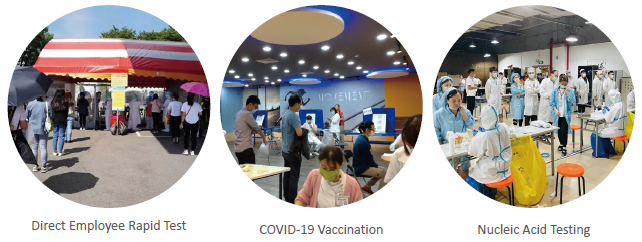
Health Promotion
To enhance occupational safety and health management and fortify health hazard identification, we adjust the focus of the yearly health promotion activities based on the analysis of employee health examination results and activity feedback to prevent chronic and occupational diseases. USI also encourage and remind employees to exercise regularly, eat and drink healthily, and maintain good living habits.
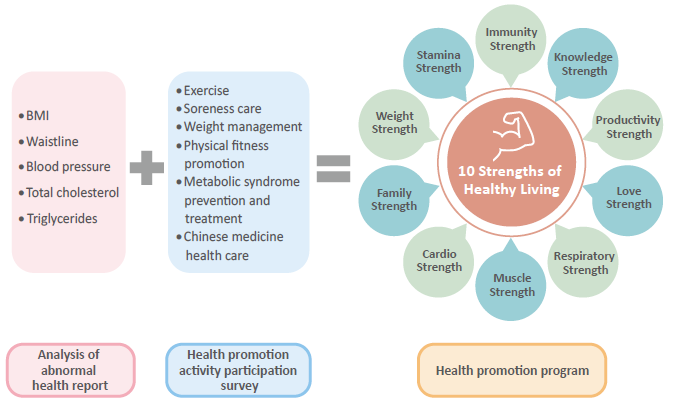
Diversified Health Promotion Activities:

- A total of 42 activities were held during the year, with a total of 13,028 participants.
- The Zhangjiang and Jinqiao Facilities jointly held a week-long occupational health promotion activity with education and training courses to enhance employees' awareness of occupational disease protection.
- The Nantou Facility was awarded the "Healthy Workplace Certification - Health Promotion Label" by the National Health Agency.
- The Nantou Facility donated 303 bags of plasma in a blood donation campaign with the participation of 200 employees.
- 588 employees participated in the Nantou Facility's weight loss activity and lost a total of 936 kg.


